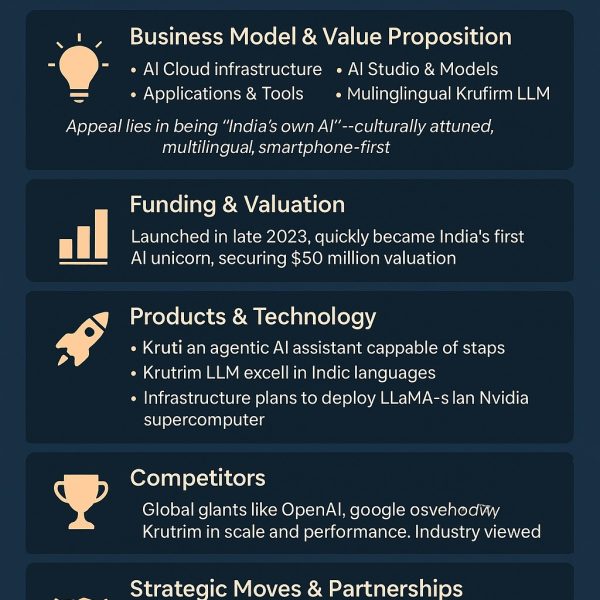Krutrim (Ola AI) – India’s AI bet vs global giants
August 23, 2025
Subject: Artificial Intelligence

Krutrim, Ola’s AI arm, has launched sovereign AI infrastructure, built a multilingual LLM with 2 trillion tokens, and unveiled Kruti, India’s first agentic AI assistant. With $230M backing and public sector partnerships, Krutrim positions itself as India’s answer to global AI leaders, despite cultural and execution challenges.
1. India’s AI Momentum and the Role of Krutrim
India’s AI market is projected to reach USD 8 billion by 2025, with annual growth rates above 35%. Government-backed initiatives such as AI skilling, data governance policies, and semiconductor manufacturing have laid the foundation for a domestic ecosystem. Against this backdrop, Krutrim—Ola’s AI venture—aims to become India’s most comprehensive AI player, spanning infrastructure, language-first large language models, and consumer-facing products.
What differentiates Krutrim is its India-first approach. While global AI platforms dominate in English and Western contexts, Krutrim focuses on India’s 22 official languages, cost-sensitive infrastructure, and everyday use cases like digital payments, mobility, and citizen services.
2. Krutrim’s Infrastructure: Sovereign, Scalable, and Local
Krutrim is building a sovereign AI cloud, designed to handle AI training and inference workloads without dependence on foreign hyperscalers. The stack includes:
- Custom silicon and chips for training AI models more cost-efficiently.
- Localized data centers, optimized for energy efficiency and Indian conditions.
- Developer-first tools for enterprises and startups to build AI applications on top of Krutrim’s cloud.
This sovereign approach aims to address concerns around data privacy, cost of compute, and technological dependence—crucial issues for a country of 1.4 billion people.
3. Kruti: India’s First Agentic AI Assistant
In 2025, Krutrim launched Kruti, an AI assistant that goes beyond chat. Unlike traditional chatbots, Kruti is agentic—it can plan, reason, and complete tasks across apps. Examples include:
- Booking cabs, ordering food, and paying bills in real time.
- Researching and presenting results in tables, summaries, or visuals.
- Supporting voice and text inputs in 13 Indian languages, with expansion to all 22 scheduled languages.
Kruti represents the next stage of AI adoption in India—moving from Q&A-style bots to full-service digital agents. Its integration with Ola’s ecosystem (mobility, food, payments) gives it a natural head start.
4. Krutrim’s Multilingual LLM: A Core Differentiator
At the core of Kruti lies Krutrim LLM, trained on over 2 trillion tokens across India’s major languages. This model outperforms leading global models in Indic languages and introduces retrieval features for real-time updates.
Key highlights:
- Supports 22 languages, making it one of the most comprehensive Indic models.
- Benchmark performance: Competitive against global leaders on reasoning and translation tasks.
- Open-source ecosystem: Portions of the model are shared with developers to encourage innovation.
This multilingual capability positions Krutrim as the go-to platform for vernacular internet users, who make up a majority of India’s digital population.
5. Funding and Strategic Moves
Krutrim became India’s first AI unicorn in 2024 with a $50 million raise at a $1 billion valuation. By early 2025, founder Bhavish Aggarwal committed $230 million from his family office, with plans to raise $1.15 billion by 2026 to fuel data centers and chip design.
The company also acquired BharatSahayak, an AI-driven citizen services platform, to embed its AI into public-facing utilities such as governance, education, and healthcare. This positions Krutrim as not just a consumer tech company but also a national infrastructure player.
6. Operational Challenges and Culture Issues
Despite its promise, Krutrim has faced challenges:
- Layoffs: Over 100 linguistics staff were let go as the company shifted focus from raw language annotation to agentic assistants.
- Senior exits: Several engineering and AI leaders departed in 2025, raising questions about culture and retention.
- Workplace stress: Reports of long hours and high-pressure environments surfaced, including a tragic case of an engineer’s suicide that sparked debate on startup culture in India.
These issues underscore the human cost of hyper-growth in AI startups and highlight the need for better governance and employee support systems.
7. Comparative Positioning
| Focus Area | Krutrim’s Strengths | Key Risks & Challenges |
|---|---|---|
| Infrastructure | India-first sovereign cloud, chip R&D, data centers | High capital intensity, competing with hyperscalers |
| AI Models | 2T-token LLM, multilingual performance edge | Needs to match global frontier models |
| Assistant (Kruti) | Agentic, task completion, multilingual support | Adoption curve, user trust, technical maturity |
| Funding | Backed by founder capital + unicorn valuation | Execution risk, dependence on future fundraising |
| Governance | Public-sector focus via BharatSahayak | Regulatory complexity, cultural controversies |
8. Industry Context: India’s AI Pathway
India’s AI race is intensifying. Startups like Sarvam AI and global entrants like OpenAI, Google, and Anthropic are competing for enterprise and consumer markets. India’s differentiator is its language diversity, cost-sensitive markets, and government support for sovereign AI infrastructure.
Krutrim’s model—combining AI infrastructure, consumer apps, and national service integration—is unique. If executed well, it can make India less dependent on foreign AI providers and potentially export Indic AI solutions to other emerging markets.
9. Future Outlook (2025–2030)
- Consumer adoption: Kruti could become a default digital agent for millions, particularly as smartphones integrate more AI features.
- Enterprise adoption: Indian businesses may prefer Krutrim’s sovereign cloud for compliance and cost savings.
- Public sector: Integration into governance and citizen services could make Krutrim a key government partner.
- Global expansion: Other emerging economies with multilingual challenges could adopt Krutrim’s AI stack.
- Cultural reset: Addressing workplace well-being will be vital to retaining top talent in a competitive market.
10. Value Investing Takeaways
- High Growth Potential: Positioned at the intersection of infrastructure, AI products, and governance, Krutrim could scale rapidly.
- Risks: Heavy capital expenditure, attrition, and global competition may challenge profitability.
- Balanced View: For investors, Krutrim is a high-risk, high-reward play—its success depends on execution, adoption of Kruti, and building a sustainable culture.
Conclusion
Krutrim is one of the boldest bets in India’s AI story—combining sovereign cloud infrastructure, a multilingual LLM, and an agentic assistant in one package. It represents a vision of AI built for India’s 1.4 billion people, tailored to their languages and everyday needs.
But ambition comes with challenges. To succeed, Krutrim must balance scaling infrastructure with cultural sustainability, capital efficiency, and user trust. If it can achieve this, it may not only define India’s AI trajectory but also emerge as a model for AI development in other diverse, emerging markets.








